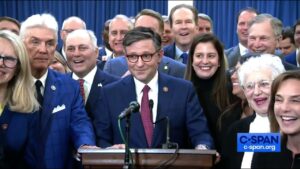Speaker Johnson’s Plan to Avoid Govt Shutdown
With the clock ticking on the 45-day stop-gap funding bill, House Speaker Mike Johnson is searching for a solution to keep the government funded without facing the risk of a shutdown. In a recent press conference, Speaker Johnson proposed a groundbreaking idea called the “laddered” continuing resolution (CR). This innovative approach aims to address the imminent government funding deadline and prevent a repeat of the political turmoil that led to the ousting of his predecessor, Speaker Kevin McCarthy.
As Speaker Johnson settles into his role, he faces the daunting task of completing the 12 spending bills required by law before the November 17 deadline. However, time is running out, and the intricate process of reconciling differences between the House and the Senate’s versions of the bills seems unattainable within the given timeframe. Speaker Johnson acknowledged this reality, stating, “We’ve run out of clock on this.”
The urgency to avoid a government shutdown stems from the repercussions of the previous fiscal year’s end. As the clock struck midnight on September 30, none of the 12 spending bills were signed into law. To avert a shutdown, Speaker McCarthy presented a 45-day stop-gap funding bill, resulting in his controversial removal from office. The decision to collaborate with Democrats and extend the Biden administration’s spending plan proved to be a political liability for McCarthy.
Speaker Johnson’s proposed laddered CR introduces a novel approach to government funding. This concept draws inspiration from the financial world, where laddered bond portfolios stagger payment schedules throughout the year instead of lump sums. Applied to the CR, this would spread due dates over a period of time, allowing negotiations for each individual bill before moving on to the next. The goal is to maintain government operations throughout the process, avoiding a complete shutdown.
While the laddered CR may offer a potential solution, it is not without its challenges. On the positive side, this approach could be more palatable to hardline Republicans who oppose short-term spending bills. By extending negotiations to cover individual appropriations bills, Speaker Johnson hopes to build consensus and prevent the can from being kicked down the road.
However, the cascading deadlines for the 12 bills could create the possibility of a partial government shutdown if funding for a specific area is not secured. Additionally, the process could become increasingly partisan, with subsequent negotiations potentially being hindered by cuts or changes made to previous bills. The success of the laddered CR hinges on the ability to navigate these challenges and maintain a delicate balance between negotiations and political interests.
To understand the scale of the laddered CR proposal, it is crucial to consider the departments and agencies covered by the 12 spending bills. These include:
- Agriculture, Rural Development, Food and Drug Administration
- Commerce, Justice, Science
- Defense
- Energy and Water Development
- Financial Services and General Government
- Homeland Security
- Interior, Environment, and Related Agencies
- Labor, Health and Human Services, Education
- Legislative Branch
- Military Construction, Veterans Affairs
- State, Foreign Operations
- Transportation, Housing and Urban Development
The laddered CR approach would require negotiations for each of these areas, potentially leading to complex discussions and delicate compromises.

As of now, the House has passed six of the 12 spending bills, with two more expected to be voted on by November 2. These bills account for a significant portion of the expected total spending. On the Senate side, three spending bills have been passed, covering a smaller portion of the budget.
With limited time left before the November 17 deadline, both the House and the Senate have a tight schedule. Nine legislative days are scheduled for each chamber, leaving little room for delays or extensive negotiations. Speaker Johnson’s ability to navigate these challenges and secure funding for the government remains uncertain.

